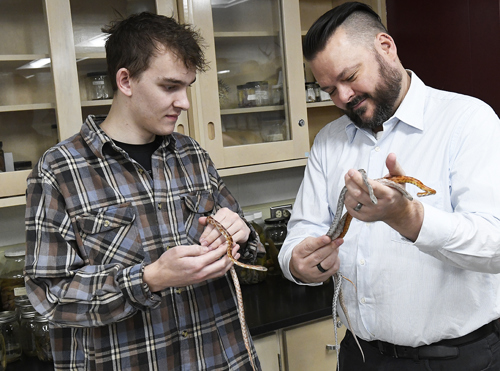
by Brittany Skinner '20
How did a female Jamaican boa snake, housed in USI's Biology Department, which has had no contact with any male snake for seven years produce a clutch of offspring? That is what Dr. Kyle Mara, Associate Professor of Biology, Dr. Kim Delaney, Interim Assistant Dean of the Pott College of Science, Engineering, and Education and Associate Professor of Biology, and undergraduate biology student David Graber '24 are investigating.
This phenomenon of a virgin birth, known scientifically as parthenogenesis (aka, asexual reproduction), is not uncommon among some snake species, but it is unheard of for the Jamaican boa species.
The research being conducted by Mara, Delaney and Graber on the Jamaican boa is considered pure or basic research, meaning it aims to improve scientific theories to better understand and predict natural phenomena. Basic research can lead to translational research, which aims to provide applicable results to directly benefit human health. Transitional research can eventually lead to clinical research, determining the safety and effectiveness of the discoveries on human subjects. While in many cases basic research does not lead to further research, it does contribute to our knowledge of the natural world we live in.
Mara is providing information about the biology of the snakes and the normal mating procedures, while Delaney and Graber are comparing the DNA of the mother and the offspring to explain how she gave birth without being bred with a male. "I have been keeping and breeding snakes and other reptiles for 18 years," says Mara of his experience. "During that time, I have successfully kept and produced offspring from dozens of species."
In species with low population sizes, such as the Jamaican boa, parthenogenesis may seem like a solution to increasing their numbers but depending on how often it occurs, it could create challenges for their survival. "If we are able to show parthenogenesis in this species, it would have significant implications for the genetic diversity of this threatened species in the wild along with captive breeding programs attempting to preserve this species," says Mara.
While creating babies via parthenogenesis would add more individuals to the total population, it would decrease genetic diversity. In most cases, sexual reproduction creates more genetic diversity which increases the chances the species could survive changes to their environment through natural selection.
If they are unable to show parthenogenesis in the Jamaican boa, the research will still prove an unusual phenomenon—that the snake stored sperm in her body for seven years. Such long-term storage is a rare occurrence in snakes and the ability of females to store viable sperm within the reproductive tract has mostly occurred in periods of months to a few years at most.
No matter their discovery, this snake has done something extremely rare and the research of Mara, Delaney and Graber into this phenomenon will not only expand our understanding of reproduction, but fertility and species conservation as well.
 The leaves are changing, and the wind is rustling through the trees as Dr. Kyle Mara, Associate Professor of Biology, leads a group of students in his herpetology course, Biology of Reptiles and Amphibians, down a road that has been closed off temporarily for the migration of thousands of snakes.
The leaves are changing, and the wind is rustling through the trees as Dr. Kyle Mara, Associate Professor of Biology, leads a group of students in his herpetology course, Biology of Reptiles and Amphibians, down a road that has been closed off temporarily for the migration of thousands of snakes.
Twice a year, in the spring and fall, 2.5 miles of Snake Road in the Shawnee National Forest in southern Illinois closes to all non-foot traffic to allow for the migration of 22 species of snakes. Weather permitting, Mara travels with USI students to observe native reptiles and amphibians in the wild. He leads the hike down the road discussing any species they encounter and the biology of why the migration takes place. In the spring, the snakes move from their winter hibernation spots into the swamps and wetlands for breeding activities and in the fall, they move from the summer breeding grounds to the bluffs where they will hibernate. The most common snake seen during the migration is a cottonmouth, or water moccasin, one of three main venomous snakes native to Illinois.
"Hands on research, whether in the classroom or outside of class activities, is at the core of USI's Pott College of Science, Engineering, and Education's mission of 'Learning by Doing'. The struggles and triumphs of designing, implementing and analyzing their own research projects gives students a valuable insight into the process of gaining new information in real-world scenarios," Mara says of the importance of research for students. "Research is frustrating at times, but the exhilaration of discovering something that no one else yet knows is one of the best parts of being a scientist."
Faculty's independent research is key to student successes, and earlier this year Dr. Brent Summers, Associate Professor of Biology, headed to TREC (Tropical Research and Education Center) in Ambergris Caye, Belize, to serve as Scholar in Residence while studying life in the Mesoamerican barrier reef, the world's second largest barrier reef. "I have several independent projects including those that are looking at the percentage of coral cover in protected versus non-protected reef areas," he said. "I'm also doing several smaller projects on marine fishes, and at least one on a marine mollusk called the 'flamingo tongue.'"
Research such as this not only provides insight and understanding to the health, diversity and ecological connections of underwater life, but it impacts the lives of Belizeans. "My research will help to protect and conserve important ecological and economic resources on the reef," Summers says. "The economy of this area is highly dependent on a strong and healthy reef ecosystem, which provides economic benefits from the tourism that it creates." Summers is uniquely familiar with the TREC facility, as he has taken groups of USI biology students there for the past 15 years, providing them an opportunity to learn about marine ecosystems. "This is a popular course with students as it provides a cost-effective short-term study abroad opportunity," he says.

Born a triplet with a serious medical condition, Brady Robinson '25 became a nurse so he could help other kids one day.

When Jacob Mills '25 experienced difficulty using a traditional mouse in 3D engineering software, he came up with his own solution.

USI's Biometrix Discover Lab reveals how friendly faces improve health outcomes.

Biology majors are not the only USI graduates who go on to work at a zoo. Learn about the behind-the-scenes workings of Evansville's Zoo from alumni who majored in art, geology, public relations, sociology and more.

